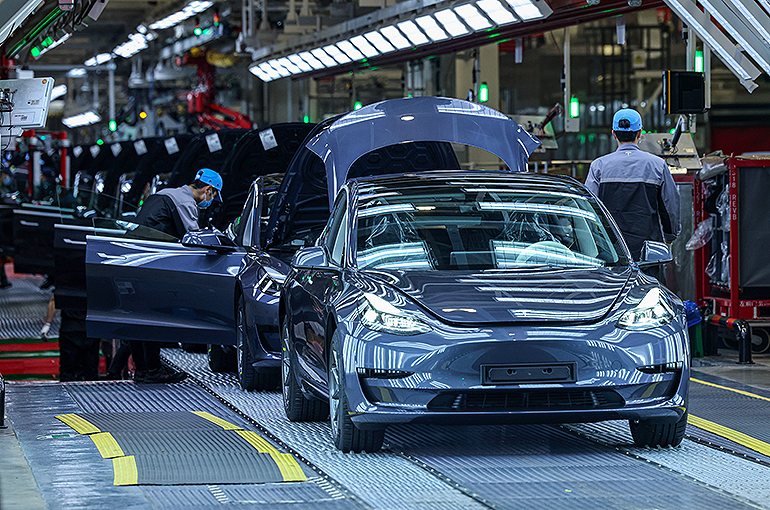 Shanghai Regains Crown as China’s Top NEV-Producing City in First Half
Shanghai Regains Crown as China’s Top NEV-Producing City in First Half(Yicai Global) July 25 -- Shanghai was the Chinese city that manufactured the most new energy vehicles in the first six months, returning to the top of the rankings after being ousted by Xi’an in northwestern Shaanxi province last year, thanks to strong sales of US EV startup Tesla’s Shanghai-made autos.
Shanghai churned out 611,500 electric cars in the six months ended June 30, while Shaanxi province produced 430,000 units, according to the latest data released by the two provincial-level regions.
Xi’an, which is home to big production bases belonging to car giants BYD and Geely, toppled Shanghai last year with an output of 1.02 million electric cars compared with Shanghai’s 988,600. This is huge turnaround from the year before, when Shanghai made 630,000 units, compared with only 269,000 in Xi’an.
Output at Tesla’s Shanghai Gigafactory surged significantly in the first half from a year earlier, which helped Shanghai regain its status as the country’s biggest NEV producer, Feng Lei, vice director of think tank Huoshi Industry Research Institute, told Yicai Global.
Shanghai is the city that makes and sells the most electric cars in China, with a penetration rate of over 50 percent, Feng said. Tesla as well as Chinese EV startups Nio and Xpeng Motors all have production bases in the metropolis.
Shanghai has a complete NEV industrial chain from raw materials to after-sales services, Feng said. It is one of the few cities in the world that is home to more than three industry leading factories and over 2,000 firms that make core components. For example, more than 95 percent of the auto parts at Tesla’s Shanghai plant are produced locally.
By contrast, Xi’an does not have a complete industrial chain. There are just 126 auto parts firms in the province and only some of them cater to the NEV sector. The NEV industry relies heavily on BYD’s network and core parts still need to be purchased from other regions, according to Huoshi Industry data.
“BYD’s Xi’an base mainly produces the plug-in hybrid model Song Plus DM-i, but the models with the fastest sales growth, the Dolphin and Yuan Plus, are made in Changsha, Shenzhen and Changzhou,” Feng said. “It will be difficult for Xi’an to stay ahead of Shanghai in terms of NEV output if it is only making BYD’s Song Plus DM-i,” he added.
Stiff Competition
Shanghai’s leads in four main aspects, Feng said. First, it has a relatively complete industrial ecology. Second, it can rely on the strong supply chain network in the Yangtze River Delta region. Third, it has a thriving consumer market. Fourth, it has integrated into the global business landscape.
But Shanghai lacks battery producers, Feng said. Batteries are at the top of the NEV value chain and account for more than 40 percent of the cost of vehicles. Also, California-based Tesla dominates the market, accounting for almost 74 percent of the city’s total NEV output last year, while Chinese marques are on the back foot.
Shenzhen, which ranked third in terms of NEV output last year, is another major competitor, but it is not able to topple Shanghai just yet, Feng said. The hi-tech hub’s output of electric cars almost tripled in 2022 from 2021 to 848,800 units.
Shenzhen’s strengths lie in the high-value links in the industrial chain, such as batteries, precision structural parts, electric motors and smart cockpits, while Shanghai’s advantages are in its ability to allocate essential resources of the global automobile industry, Feng added.
Editors: Tang Shihua, Kim Taylor